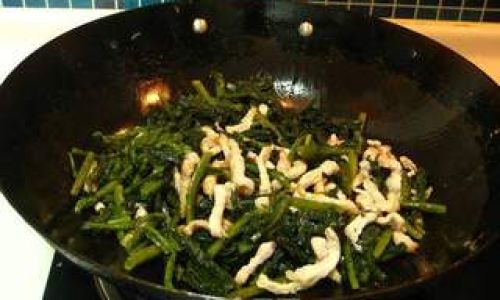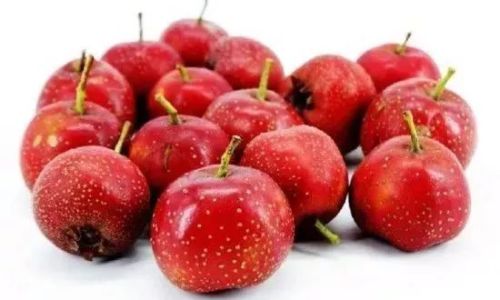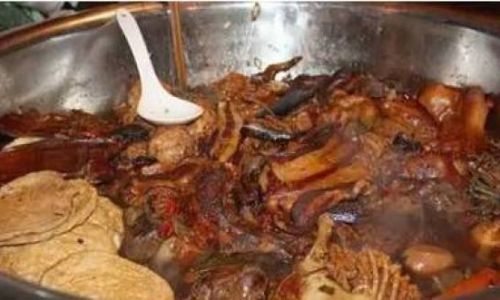Introduction
In the vast culinary landscape of Chinese cuisine, stir-fries occupy a unique and prominent position. They are quick, delicious, and versatile, allowing for endless combinations of ingredients to create dishes that are both comforting and exciting. One such classic stir-fry is Pork Shreds Stir-Fried with Potherb Mustard, a dish that combines the tender, savory flavors of pork with the crisp, slightly bitter taste of potherb mustard (also known as snow cabbage or Brassica juncea). This dish is not only a staple in many Chinese households but also a favorite among those who appreciate the harmony of flavors that Chinese cooking excels at.
In this article, we will delve into the intricacies of making Pork Shreds Stir-Fried with Potherb Mustard. From selecting the right ingredients to mastering the cooking technique, we will cover every step to ensure that you can recreate this delicious dish at home. Whether you are a seasoned chef or a novice in the kitchen, this guide will provide you with the knowledge and skills necessary to bring this classic Chinese stir-fry to life.
Ingredients Selection

Before we begin cooking, it is crucial to select the right ingredients. The quality of your ingredients will directly impact the final taste and texture of your dish. Here is a detailed breakdown of what you need:
-
Pork Shoulder or Pork Belly (for Shreds):
- Pork shoulder or pork belly are ideal for stir-fries because they have a good balance of fat and lean meat, which results in juicy, tender shreds when cooked properly.
- Look for pork that is fresh, with a firm texture and a pinkish hue. Avoid pork that has a grayish color or a slimy texture, as it may be past its prime.
-
Potherb Mustard (Snow Cabbage):
- Potherb mustard is a cruciferous vegetable with dark green leaves and thick stems. It has a slightly bitter taste and a crisp texture when cooked.
- Choose potherb mustard that has fresh, vibrant green leaves and firm stems. Avoid bunches that have yellowing leaves or soft, wilted stems.
-
Aromatics and Seasonings:
- Garlic: Fresh garlic cloves add a pungent, savory flavor to the dish.
- Ginger: Fresh ginger root provides a subtle sweetness and a hint of spice.
- Soy Sauce: Use a high-quality soy sauce for the best flavor. Light soy sauce is preferred for this dish as it has a milder taste and lighter color.
- Oyster Sauce: Oyster sauce adds a rich, umami flavor to the stir-fry.
- Shaoxing Wine (or Dry Sherry): This Chinese rice wine enhances the flavors of the pork and vegetables.
- Salt and Pepper: To taste.
- Cooking Oil: A neutral oil like vegetable oil or canola oil is best for stir-frying, as it has a high smoke point and does not impart any strong flavors.
-
Starch (for Thickening, Optional):
Cornstarch or potato starch can be used to create a light gravy that coats the pork shreds and vegetables, making the dish more moist and flavorful.
Preparation
Now that we have our ingredients, let’s move on to the preparation stage. Proper preparation is key to ensuring that your stir-fry cooks evenly and tastes delicious.
-
Slicing the Pork:
- Begin by slicing the pork shoulder or pork belly into thin shreds. Aim for shreds that are about 1/4 inch thick and 2 inches long. This will ensure that they cook quickly and evenly in the stir-fry.
- Place the pork shreds in a bowl and marinate them with a tablespoon of soy sauce, a teaspoon of Shaoxing wine, and a pinch of salt and pepper. Mix well and let the pork sit for at least 15 minutes to absorb the flavors.
-
Preparing the Potherb Mustard:
- Rinse the potherb mustard thoroughly under cold running water to remove any dirt or debris.
- Pat the leaves and stems dry with paper towels. Excess moisture can cause the stir-fry to steam rather than sear, which will result in a less crispy texture.
- Separate the leaves from the stems. The stems take longer to cook, so they will be added to the stir-fry first. Slice the stems into thin strips and chop the leaves into bite-sized pieces.
-
Preparing the Aromatics:
- Peel the garlic cloves and mince them finely.
- Peel the ginger root and slice it into thin matchsticks or mince it as well.
Cooking the Stir-Fry

With all our ingredients prepared, it’s time to cook the stir-fry. Stir-frying is a quick cooking method that requires high heat and constant stirring to ensure that the ingredients cook evenly and do not burn.
-
Heating the Wok or Pan:
Place a wok or a large, flat-bottomed pan over high heat. Preheat it for about 2-3 minutes until it is very hot. This is crucial for creating a sear on the pork and vegetables, which adds flavor and texture.
-
Adding Oil:
Pour in about 2 tablespoons of cooking oil and swirl it around the wok or pan to coat the surface evenly.
-
Stir-Frying the Aromatics:
Once the oil is hot (it should shimmer but not smoke), add the minced garlic and ginger. Stir-fry for about 30 seconds until they become fragrant and slightly golden. Be careful not to let them burn, as this will make the dish bitter.
-
Cooking the Pork Shreds:
- Push the aromatics to the side of the wok or pan and add the marinated pork shreds in a single layer, spreading them out as much as possible. Let them sear for about 1 minute without stirring, allowing a nice crust to form on the bottom.
- Stir the pork shreds and continue to cook for another 1-2 minutes, stirring occasionally, until they are lightly browned and cooked through. If the pork starts to stick to the wok or pan, add a little more oil.
-
Adding the Potherb Mustard Stems:
Add the sliced potherb mustard stems to the wok or pan and stir-fry for about 2 minutes, stirring occasionally, until they begin to soften.
-
Adding the Leaves and Seasonings:
- Add the chopped potherb mustard leaves to the wok or pan and stir-fry for another 1-2 minutes until they are wilted and tender.
- Pour in the remaining marinade (if any), along with an additional tablespoon of soy sauce, a teaspoon of oyster sauce, and a teaspoon of Shaoxing wine. Stir well to combine and let the flavors meld together for about 30 seconds.
-
Thickening (Optional):

If you prefer a thicker sauce, mix a teaspoon of cornstarch with a tablespoon of water to create a slurry. Pour this mixture into the wok or pan and stir well to combine. The sauce will thicken as it cooks for another 30 seconds to 1 minute.
-
Tasting and Adjusting Seasoning:
Taste the stir-fry and adjust the seasoning with additional salt and pepper if necessary. Remember that the soy sauce and oyster sauce already contain salt, so you may not need to add much more.
-
Serving:
Transfer the Pork Shreds Stir-Fried with Potherb Mustard to a serving dish and serve immediately. This dish is best enjoyed hot, as the flavors and textures are at their peak.
Conclusion
Pork Shreds Stir-Fried with Potherb Mustard is a classic Chinese stir-fry that combines the savory flavors of pork with the crisp, slightly bitter taste of potherb mustard. By following the steps outlined in this article, you can recreate this delicious dish at home, using fresh, high-quality ingredients and mastering the art of stir-frying.
This dish is not only delicious but also nutritious, as potherb mustard is rich in vitamins and minerals, including vitamin C, vitamin K, and calcium. Pork provides a good source of protein and essential fatty acids. Together, these ingredients make for a balanced and satisfying meal that is perfect for any occasion.
Whether you are cooking for yourself, your family, or friends, Pork Shreds Stir-Fried with Potherb Mustard is sure to impress with its harmonious blend of flavors and textures. So, the next time you are in the mood for a quick and delicious stir-fry, give this classic Chinese dish a try. With a little practice, you’ll be able to perfect your technique and create a stir-fry that is as good as any you’ve had in a restaurant.
Remember, the key to successful stir-frying is high heat, constant stirring, and using fresh, high-quality ingredients. With these principles in mind, you can adapt this recipe to include other ingredients and flavors, creating endless variations that suit your taste preferences. Happy cooking!






0 comments